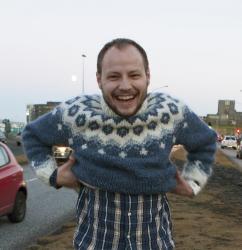Hlynur Páll Pálsson discusses the Reykjavík Dance Festival
The Reykjavík Dance Festival has changed nearly as much as the art of dance itself in its twelve years of existence. But a change of directors and board members this spring has brought on much more drastic changes to its scope and concept for coming years. In conversation with the Grapevine, managing director Hlynur Páll Pálsson explained how.
Creating a pulse
When the concept began, there was not a dance program at Iceland Academy of Arts, or many independent dance companies. Hlynur says that RDF’s beginnings were “basically a grassroots thing: people making a festival for themselves to show their works in Iceland.” It took off from there. “It’s been growing in the past twelve years, almost exponentially. Both in audience number and in the amount of works shown.”
Hlynur is no stranger to performance. Working for years as a stage and production manager at Borgarleikhúsið, he stepped into his directorship at RDF in April, alongside new creative directors Alexander Roberts and Ásgerður G. Gunnarsdóttir. “We felt the August festival had become as big as it could get,” he said, “we wanted to expand into four festivals instead.”
Rather than one ten-day festival in August, they planned two larger festivals in May and August, with shorter festivals in November and February to keep dance in the city’s consciousness more regularly. “Before, everyone came together only once a year,” he explains. “We wanted to create a pulse, like a heartbeat of the dance scene.”
Queering the popular
Each incarnation has a different concept. August’s focused entirely on works by Icelanders. “Queering the popular” is the concept November’s performances will tackle.
“Pop culture is continually citing itself, creating itself, and redesigning its identity,” Hlynur says. “That’s what art is: challenging normality. We’re fans of taking normal things and twisting them around to get people to rethink them and reshape themselves.” Using the Icelandic word “snertiflötur,” or “touch point,” he explains that each piece either explicitly or subtly touches on the nebulous topic of pop culture.
In addition to challenging concepts of pop culture in the upcoming festival, RDF has always been pushing the limits of the art form of dance. The new schedule reflects this. There’s “danceoke,” where music videos with iconic dances are played and people attempt to dance along. There’s a “heated debate” where both dancers and audiences are invited to swim together and discuss dance in the hot tubs at Sundhöll Reykjavíkur. There are also events that bring dance to radio and film.
One event features particularly unique performances by the lead singers of three iconic Icelandic bands: Unnsteinn of Retro Stefson, Kata of Mammút, and Gunnar of Grísalappalísa. Choreographers Alexander Roberts and Ásrún Magnúsdóttir have studied the musicians’ live performances and choreographed dances for them to perform based on their own stage presences. Hlynur elaborates: “What they do onstage with the bands is a dance. But now it’s being focused into a solo with no band—just them, moving.”
You don’t have to be drunk to dance
“Where does dance end and the other arts begin?” he asks me. “We’re continually trying to figure out what this thing that we enjoy watching and doing really is. Because RDF is not only about watching dance, it’s also about getting people to dance.” In August, one event took place in the homes of dancer Ásrún and her neighbours. In the middle of the day, each played their favourite music and opened their doors to strangers to come and dance with them.
“People are realizing that you don’t have to be drunk to dance,” Hlynur says. Because Reykjavík Dance Festival is not necessarily about the brain. Alongside the “heartbeat” of four festivals per year, this is why the brochures for their August festival centred on the design of a human heart. “You’re not trying to understand stuff,” he says. “You’re just taking it in, the emotions or the beauty or the ugliness or whatever you see.”
“Of course it can get you thinking,” he adds, “but to us, it’s also about the heart.”
—
See Also:
Reykjavík Dance Festival Opening Show
Buy subscriptions, t-shirts and more from our shop right here!
















